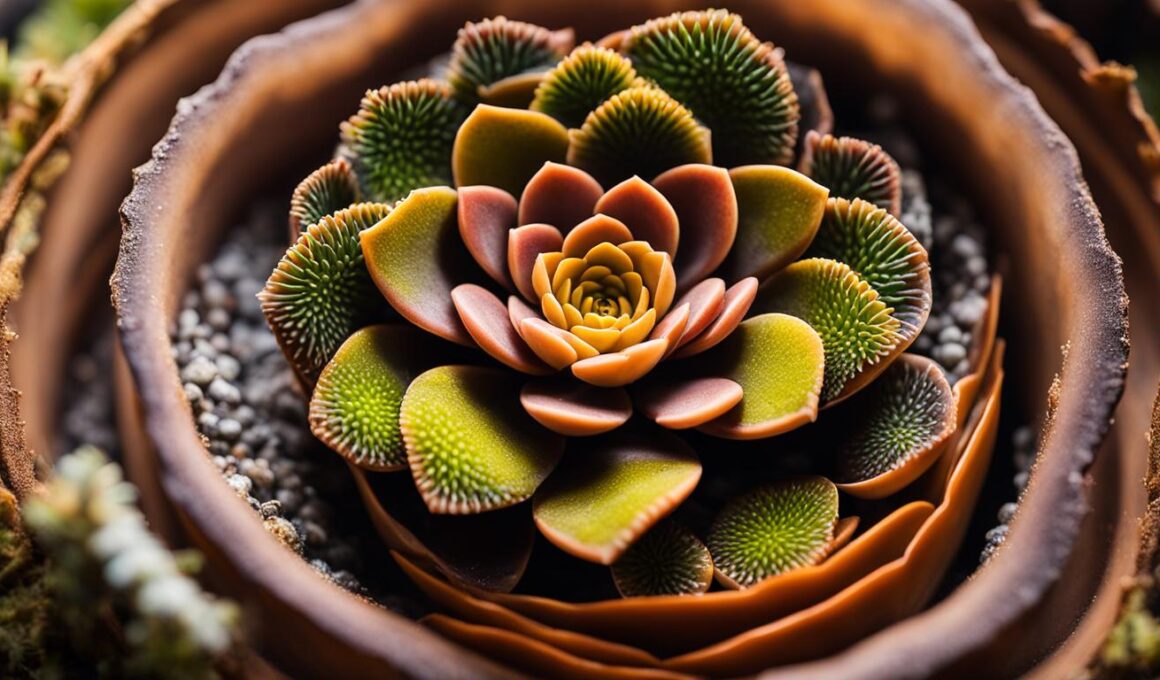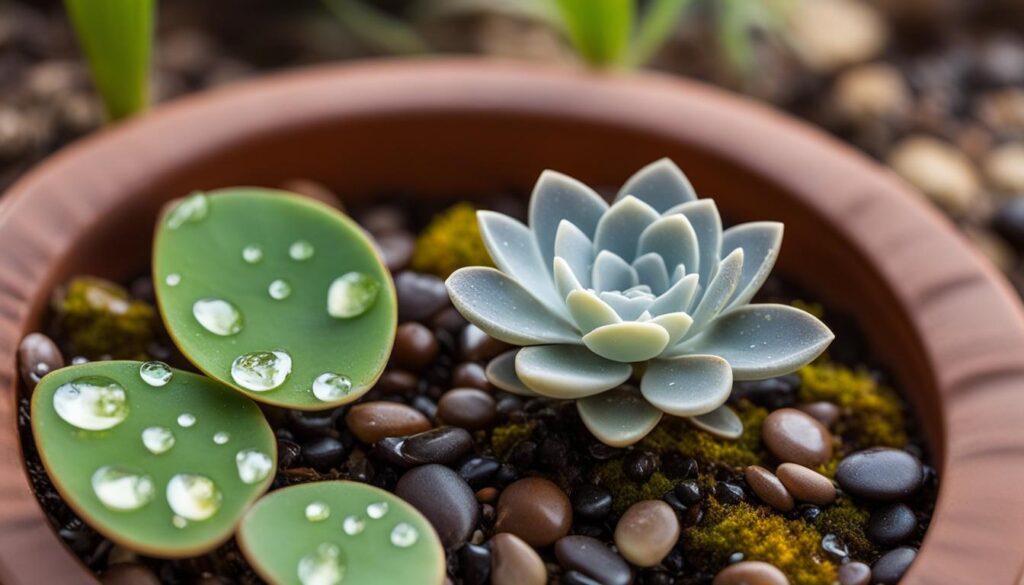Welcome to the world of lithops, also known as “living stones”! These unique succulent plants have captivated gardeners and plant enthusiasts with their extraordinary ability to undergo a natural process called splitting. In this article, we will delve into the fascinating world of lithops splitting, exploring why it happens, how to identify the signs, and most importantly, how to care for these living stones during this remarkable phase of their lifecycle.
Post Summary
- Lithops undergo a natural process called splitting, which is a normal part of their growth cycle.
- During splitting, new leaves emerge as the old leaves shrink and drop off.
- It is essential not to disturb the splitting process by watering the lithops during this phase.
- Proper light and adequate drainage are crucial for the lithops to thrive during splitting.
- Understanding the watering needs of lithops during different seasons is vital for their care.
The Characteristics of Lithops Plants
Lithops, also known as “living stones,” are fascinating succulent plants that possess unique characteristics that set them apart from other plants. These visually appealing plants have become popular among succulent enthusiasts and gardeners alike. Here are some key characteristics of lithops that make them stand out:
Leaf Resembling Stones
The Normal Splitting Process of Lithops
Lithops undergo a natural splitting process as part of their expected growth cycle. This process occurs when the plant is ready to produce new leaves or flower buds. The splitting starts at the edges of the existing leaves, creating a gap for the emergence of new leaves. This gradual process can take several weeks, during which the old leaves shrink and eventually drop off, making room for the new ones.
This normal splitting process allows lithops to renew themselves and continue their growth. It is an essential part of their lifecycle and should be embraced rather than seen as a sign of distress. By allowing lithops to split naturally, you promote healthy plant development and ensure their continued growth.
“Lithops splitting is a fascinating and magical sight to witness. It showcases the plant’s ability to rejuvenate and adapt to its environment. By understanding the expected growth cycle and caring for lithops properly during splitting, you can ensure their continued health and enjoy their unique beauty as they grow and change.”
| Benefits of Natural Splitting | Effects of Interfering with Splitting |
|---|---|
|
|
How to Care for Lithops During Splitting
During the splitting cycle of lithops, it is crucial to provide the right care to ensure their healthy growth. One of the most important aspects of caring for lithops during splitting is to avoid disturbing the natural process. This means refraining from watering the plant while it is going through splitting, as excessive moisture can disrupt leaf production and impede the growth of new leaves.
Lithops require proper light during the splitting phase to thrive. Place them in a location where they can receive bright, indirect sunlight. Providing adequate light will support the growth of new leaves and help the plant complete its splitting cycle successfully.
In addition to light, it is essential to ensure that the pot has proper drainage. Lithops are susceptible to root rot if their roots sit in waterlogged soil. Choose a pot with drainage holes and use a well-draining soil mix specifically designed for succulent plants. This will prevent excess moisture and help maintain the health of your lithops during the splitting process.
Caring for Lithops During Splitting: Key Points
- Avoid watering lithops while they are splitting to allow the natural process to unfold without disruption.
- Provide bright, indirect sunlight to support the growth of new leaves.
- Ensure the pot has proper drainage to prevent excess moisture and root rot.
By following these care guidelines, you can help your lithops complete their splitting cycle successfully and ensure their continued health and growth.
Watering Frequency for Lithops
Proper watering is essential for the health and well-being of lithops during their growth cycle. As succulent plants, they have unique water needs that differ from other houseplants. Understanding the watering frequency for lithops is crucial to ensure their optimal care and growth.
Succulent Care: Watering Lithops
Lithops are adapted to arid environments and have low water requirements. It is important to avoid overwatering, as this can lead to root rot and other issues. The frequency of watering lithops depends on factors such as the age, size, temperature, and humidity of the plant.
During the summer, lithops go into a period of dormancy and should not be watered. Allow the soil to dry out completely before watering, which usually occurs every 1-2 weeks. In the winter, lithops require even less water. It is best to water them only once a month or when the soil is completely dry.
During the splitting phase, it is crucial to avoid watering completely. The lithops utilize the moisture stored in their leaves for the splitting process. Overwatering can disrupt the natural cycle and cause damage to the new leaves inside. Adjust your watering schedule to meet the specific needs of your lithops and ensure their successful development.
| Season | Watering Frequency |
|---|---|
| Summer | No watering required |
| Winter | Once a month or when soil is completely dry |
| Splitting Phase | Avoid watering completely |
Watering Lithops During Different Seasons
Proper watering is critical to the health and well-being of lithops. Understanding their watering needs during different seasons is essential for their proper care. Here’s a guide to help you water your lithops based on the time of year.
Summer:
During the summer months, lithops go into a period of dormancy. It is crucial not to water them during this time, as they require less moisture. Instead, allow the soil to dry out completely before watering again. This mimics the arid conditions of their natural habitat and helps prevent overwatering, which can lead to root rot and other issues.
Winter:
In winter, lithops also enter a period of dormancy. During this time, they rely on the moisture stored in their leaves for sustenance. It is important not to water them during this period to avoid causing the leaves to swell and potentially harm the new growth inside. Let the lithops absorb moisture from their old leaves, and only resume watering once new growth begins in spring.
Spring:
As lithops start their active growth phase in spring, you can gradually begin watering them again. However, it’s crucial to water lightly and ensure the soil has dried out between waterings. Overwatering can lead to root rot and other issues, so it’s important to strike a balance. Monitor the soil moisture levels and adjust your watering frequency accordingly.
Autumn:
During early autumn, lithops should be watered regularly, but only when the soil has completely dried out since the last watering session. As the days become shorter and temperatures begin to drop, lithops prepare for their dormant period. The key is to avoid overwatering and allow the lithops to enter dormancy naturally.
| Season | Watering Recommendation |
|---|---|
| Summer | Avoid watering, let the soil dry out completely |
| Winter | Avoid watering, let lithops absorb moisture from old leaves |
| Spring | Gradually resume watering, but water lightly and ensure the soil dries out between waterings |
| Autumn | Water regularly, but only when the soil has completely dried out since the last watering |
By understanding the watering needs of lithops during each season, you can provide them with the care they need to thrive. Remember, moderation is key when it comes to watering lithops, and it’s essential to let nature guide their growth cycle.
Lithops Multiplication: Understanding the Slow Growth and Clumping
Lithops multiplication is a gradual and slow process that requires patience and careful observation. These unique succulent plants have a natural growth habit that involves the formation of new plants alongside the mother plant. As the lithops mature, they produce flowers that eventually disperse seeds, contributing to the multiplication of these fascinating living stones.
The Clumping Phenomenon
One interesting aspect of lithops multiplication is the clumping phenomenon. Many gardeners choose to keep multiple lithops in the same pot to create visually appealing clusters. Over time, as the plants multiply, they form dense clumps of intertwined leaves, creating a stunning display. This clumping not only adds visual interest but can also improve the plants’ overall resilience and ability to withstand harsh conditions.
To achieve successful clumping, it is important to provide adequate space between the lithops plants in the early stages of growth. This allows each plant to develop its own root system and prevents overcrowding. As the lithops multiply and form clumps, regular repotting may be necessary to accommodate the expanding cluster.
Lithops Multiplication: The Numbers Game
It’s worth noting that lithops multiplication is a slow process. Seedlings usually appear alongside the mother plant and gradually increase the number of plants in the pot. This gradual multiplication can take several years, requiring patience and careful cultivation. However, the wait is well worth it for those who appreciate the unique beauty and charm of these living stones.
| Factors Affecting Multiplication | Impact |
|---|---|
| Age of the Lithops | The older the lithops, the more likely it is to multiply. |
| Environmental Conditions | Optimal growing conditions promote healthy growth and multiplication. |
| Proper Care and Maintenance | Providing the right amount of water, light, and nutrients supports lithops multiplication. |
By understanding the slow growth and clumping nature of lithops, you can appreciate the fascinating journey these plants undertake. Patience and proper care are key to successful multiplication, allowing you to enjoy the beauty of a thriving lithops cluster in your home or garden.
The Importance of Natural Splitting in Lithops
One of the most fascinating aspects of lithops plants is their natural ability to split. This unique process is essential for their healthy growth and development. Natural splitting allows lithops to renew their leaves, ensuring that they continue their lifecycle successfully.
During splitting, new leaves emerge from the gaps created as the old leaves shrink and eventually drop off. This natural growth process is crucial for lithops because it allows them to replenish their foliage and maintain their overall health. Tearing or removing leaves can disrupt the plant’s growth cycle and result in damage or stunted growth.
By allowing lithops to split naturally, you are promoting their overall well-being and ensuring successful development. It is important to avoid interfering with the process and to provide the proper care and conditions to support their natural growth. This includes providing adequate light and ensuring the pot has proper drainage to prevent overwatering, which can be detrimental to the splitting process.
Benefits of Natural Splitting:
- Renewal and regeneration of foliage
- Maintenance of the plant’s overall health
- Ensures successful development and growth
Natural splitting is a remarkable part of lithops’ growth cycle. By understanding its importance and providing the necessary care, you can ensure that your lithops thrive and continue to captivate with their unique beauty.
The Role of Watering in Lithops Splitting
During the process of lithops splitting, proper watering plays a crucial role in ensuring the successful growth and development of these unique plants. It is important to understand the effects of overwatering and how to avoid them to maintain the health of your lithops.
Overwatering can disrupt the splitting process and cause the leaves to swell, potentially harming the new leaves that are emerging. Lithops naturally utilize the moisture stored in their leaves during this phase, so additional watering is not needed. By abstaining from watering during splitting, you allow the plant to utilize its own resources and follow its natural growth cycle.
“Watering is a critical aspect of caring for lithops during splitting. Remember to refrain from overwatering, as this can interfere with the natural process and harm the new leaves. Let the plant rely on its own stored moisture and continue splitting at its own pace.” – Lithops Enthusiast
Proper watering management is essential to prevent overwatering and ensure the well-being of your lithops. It is recommended to water lithops only when the soil is completely dry. Adjust the watering frequency based on factors such as the age, size, temperature, and humidity of the plant. By exercising caution and providing the appropriate watering conditions, you can support the healthy growth and splitting of your lithops.
| Effects of Overwatering | How to Avoid Overwatering |
|---|---|
| 1. Swollen leaves that can damage emerging new leaves | 1. Refrain from watering during lithops splitting |
| 2. Risk of root rot and fungal infections | 2. Water lithops only when the soil is completely dry |
| 3. Stunted growth and potential plant decline | 3. Adjust watering frequency based on plant needs and environmental factors |
By understanding the importance of proper watering during lithops splitting and avoiding overwatering, you can promote the successful growth and development of these fascinating plants.
The Growth Cycle of Lithops and Flowering
Lithops have a fascinating growth cycle that spans several stages, including dormancy, splitting, active growth, and flowering. Each stage plays a vital role in the overall development of these unique succulent plants. Understanding the growth cycle of lithops will help you better care for them and appreciate their beauty.
1. Dormancy:
During the dormancy stage, which typically occurs in the summer months, lithops enter a period of rest. They slow down their growth and conserve energy to survive in arid conditions. This is a crucial time to refrain from watering, as lithops use the moisture stored in their leaves to sustain themselves.
2. Splitting:
The splitting stage is a natural process in the lithops growth cycle. It often occurs during spring or fall when the plant is ready to produce new leaves or flower buds. The old leaves shrink and create a gap where new leaves emerge. This process can take several weeks, and it is essential to avoid disturbing the plant during this phase. Allow the new leaves to grow naturally.
3. Active Growth:
After splitting, lithops enter a period of active growth. This is when the new leaves start to develop and mature. During this stage, it is important to provide proper light and ensure the pot has adequate drainage for the lithops to thrive. Adjust the watering frequency based on the age, size, temperature, and humidity of the lithops.
4. Flowering:
Once lithops reach a minimum age of three years, they have the potential to produce flowers. Flowering usually occurs during the active growth stage, and it is a beautiful sight to behold. During this stage, it is recommended to reduce watering to simulate the arid habitat of lithops and promote successful pollination and seed production.
By understanding the growth cycle of lithops, you can provide the necessary care and create an optimal environment for these fascinating plants to thrive. Remember to be patient, as lithops reproduce slowly and take time to multiply. Enjoy the beauty of their splitting and flowering stages, and marvel at the magic of these living stones renewing their lifecycle.
Conclusion
In conclusion, lithops splitting is a natural and fascinating process in their growth cycle. By understanding the signs and providing proper care during this phase, you can ensure the continued health and beauty of your lithops plants.
During splitting, it is crucial not to disturb the process and avoid watering the plant. Let nature take its course as the old leaves shrink and drop off, making way for new leaves to emerge. Provide adequate light and ensure proper drainage for your lithops to thrive.
Remember, lithops are succulent plants that require less water compared to other plants. Adjust the watering frequency based on the age, size, temperature, and humidity of your lithops. During splitting, it is important to avoid watering completely, as the plant utilizes the moisture stored in its leaves for the process.
By following these care guidelines and allowing lithops to split naturally, you promote their overall health and ensure successful development. Appreciate the unique beauty of your lithops as they grow, change, and continue their lifecycle.
Can Epsom salt affect the lifecycle of Lithops?
Epsom salt has been touted as a natural weed killer, but it can also impact the lifecycle of Lithops, a type of succulent. When used in high concentrations, natural weed killer epsom salt can alter the soil composition and affect the water balance within the Lithops, potentially disrupting its growth and development.
FAQ
Why do lithops split?
Lithops split as part of their natural growth cycle when they are ready to produce new leaves or flower buds.
How long does the splitting process take?
The splitting process can take several weeks as the old leaves shrink and new ones emerge.
Should I water my lithops while it is splitting?
No, it is important to avoid watering the plant during splitting to avoid disrupting the leaf production cycle.
How often should I water lithops?
Water lithops only when the soil is completely dry, typically every 1-2 weeks in the summer and once a month in winter.
Can I water my lithops during the summer and winter?
In summer, lithops go into dormancy and should not be watered. In winter, avoid watering and let the plant absorb moisture from the old leaves.
How do lithops multiply?
Lithops reproduce slowly through seedlings that grow alongside the mother plant.
Is splitting important for the growth of lithops?
Yes, splitting allows lithops to renew their leaves and continue their lifecycle, promoting overall health and successful development.
Can overwatering disrupt lithops splitting?
Yes, overwatering during splitting can disrupt the process and potentially harm the new leaves inside.
When do lithops flower?
Lithops typically start flowering after reaching a minimum age of three years.
What is the importance of caring for lithops during splitting?
Proper care during splitting ensures the continued health and growth of lithops, allowing them to thrive and change as they should.













